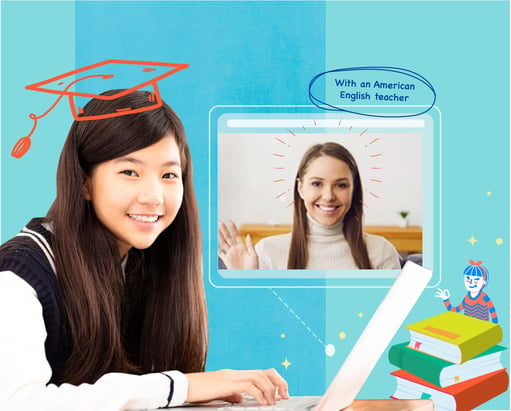Learning English by Telephone vs. Online Video Calls: A Comprehensive Comparative Guide for Language Learners
In today's globalized world, English has become a vital skill for success, and learning it has become more accessible than ever. Two popular methods for learning English, especially among non-native kids, are telephone lessons and online video calls. This blog will discuss the pros and cons of both methods to help you decide which is more suitable for your child.

Learning English by Telephone
Pros:
- Improves listening skills: As there are no visual aids, students have to rely on their listening skills to understand the content. This helps them practice and sharpen their listening abilities, which can be useful for exams where no visual aids are available.
- Flexibility: Telephone lessons can be scheduled at the convenience of the student and the teacher, without the need for high-speed internet or video-enabled devices.
- Less intimidating: For shy students or those with anxiety, telephone lessons may feel less daunting, as they don't have to show themselves on camera.
If you haven't already, be sure to get our free full guide to teaching your own students.
Cons:
- No visual aids: The lack of visual cues can make it difficult for students to understand certain concepts, especially if they are visual learners.
- Limited interaction: Without visual aids, students might struggle to fully engage with the teacher or their peers, which can impede their learning progress.
- Pronunciation and accent difficulties: It might be harder for students to mimic the teacher's pronunciation and accent without seeing their mouth movements and facial expressions.

Learning English with Online Video Calls
Pros:
- Visual aids: Online video calls allow teachers to use visual aids, such as PowerPoint presentations, images, and videos, which can help students understand complex concepts more easily.
- Better pronunciation and accent training: Video calls enable students to see the teacher's mouth movements and facial expressions, making it easier to mimic pronunciation and accent.
See NSEO student success stories here:
- Interactive learning: Online video calls allow for more interactive learning experiences, such as group activities, role-plays, and games, which can boost students' engagement and motivation.
- Non-verbal communication: Students can practice and develop non-verbal communication skills, such as facial expressions and body language, which are essential in real-life conversations.
Cons:
- Technical issues: Video calls may experience lag, poor audio quality, or connectivity issues, which can disrupt the learning process.
- Dependency on internet access: Students need a stable and high-speed internet connection, as well as a video-enabled device, to participate in video call lessons.
- Privacy concerns: Some students or parents might feel uncomfortable with the idea of having their video and audio recorded, especially in group classes.
Why Video Call English Lessons Are More Effective for Students
While telephone English lessons have their benefits, video call English lessons tend to be more effective in addressing a wider range of language skills, especially for beginner and intermediate students.
The use of visual aids, real-time interactions, and multimedia resources in video call lessons helps students to better understand the language, and it allows them to practice all aspects of language learning: listening, speaking, reading, and writing.
For example, video call lessons can incorporate shared documents or online whiteboards, enabling students to practice reading and writing simultaneously with speaking and listening. This comprehensive approach ensures that students receive a well-rounded language learning experience, ultimately making it more effective and efficient.

Moreover, video call lessons can cater to different learning styles, accommodating visual, auditory, and kinesthetic learners. Teachers can employ various teaching methods, such as using videos, interactive games, or even virtual reality, to engage students and make the learning process more enjoyable and memorable.
Lastly, video call lessons provide students with the opportunity to interact with their teachers and peers in real-time.
Video calls enables them to receive immediate feedback, ask questions, and clarify doubts, which can significantly enhance their learning experience.
Additionally, real-time interactions can help students develop their confidence and fluency in spoken English, as they are encouraged to think and respond quickly in a dynamic environment.
Want guidance on increasing your child's confidence in speaking English?
Despite the potential technical issues and the need for reliable internet access, video call English lessons offer a more comprehensive and adaptable learning experience, making them generally more effective for students.

By addressing all aspects of language learning and catering to various learning styles, video call lessons can help non-native kids become more proficient in English in a shorter amount of time.

If you haven't already, be sure to get our free full guide to teaching your own students.



